What is Net Promoter Score (NPS) and How Game Publishers Can Use Real-Time, In-Game Feedback To Improve It

Net Promoter Score (NPS) may not be the first thing you think of when growing your business. But by improving this key metric, it can have a much bigger impact than you realize.
If reducing player churn, increasing player acquisition, retention, and LTV are all things you're interested in, then you need to understand what Net Promoter Score is and how it works. Because improving your Net Promoter Score is critical to a healthy buzz-worthy game, and a thriving business.
But improving Net Promoter Score is a process, and understanding and streamlining that process can have exponential benefits on your bottom line. And the best part, improving your NPS is faster and easier than you think.
Before we get into all of that, you need to know what NPS is, how to measure it, how to track it, and the strategies used to positively affect it.
In this post, we’ll cover…
- What Is Net Promoter Score (NPS)?
- What Is A Good Net Promoter Score?
- Benefits Of NPS
- Transactional vs Relational NPS
- How To Use Your App to Improve Your NPS
- Using Rewarded In-Game Surveys To Boost Your NPS
- The Net Promoter Score Survey Question
What Is Net Promoter Score (NPS)?
The Net Promoter Score® (or NPS) measures the loyalty of customers to a company. In your case, you can think of it as measuring the loyalty of your players to your game. The kicker is, NPS measures loyalty with one simple, yet powerful question: “How likely is it that you would recommend [Organization X/Product Y/Service Z] to a friend or colleague?”
You might be wondering how much value can one question really have for a business.
Well, according to his article in the Harvard Business Review titled, “One Number You Need to Grow.” renowned business strategist, Fred Reichheld, discovered that after testing roughly 20 questions, “How likely is it that you would recommend [Organization X/Product Y/Service Z] to a friend or colleague?” has the strongest correlation to repeat purchases or referrals.
Furthermore, Mr. Reichheld exclaims, “...evangelistic customer loyalty is clearly one of the most important drivers of growth. While it doesn’t guarantee growth, in general profitable growth can’t be achieved without it.”
Clearly, it’s a significantly insightful question.
The NPS Answer Scale
Respondents provide an answer on a 0-10 scale that looks like this…
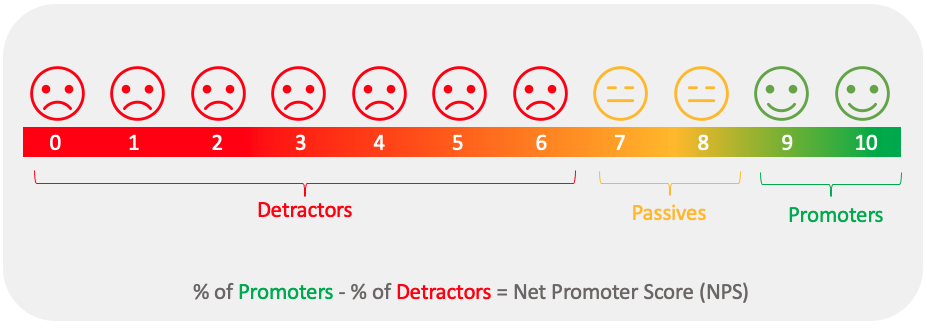
As you can see in the image above, the NPS breaks down as follows:
Promoters (9 or 10): these are your loyal and enthusiastic players. They are likely to promote your game by sharing their great gaming experience with friends, family, and coworkers.
Passives (7 or 8): these are satisfied players that aren’t crazy about your game but don’t hate it either.
Detractors (0 to 6): these are unhappy players who really don’t like your game for one reason or another, are likely to delete your game, and even discourage others from playing it.
Calculating Your NPS
Figuring out your NPS is pretty easy. All you have to do is subtract your % of Detractors from your % of Promoters and you’ve got your NPS.
But what about Passives? They don’t count - at least not when it comes to calculating NPS, anyway.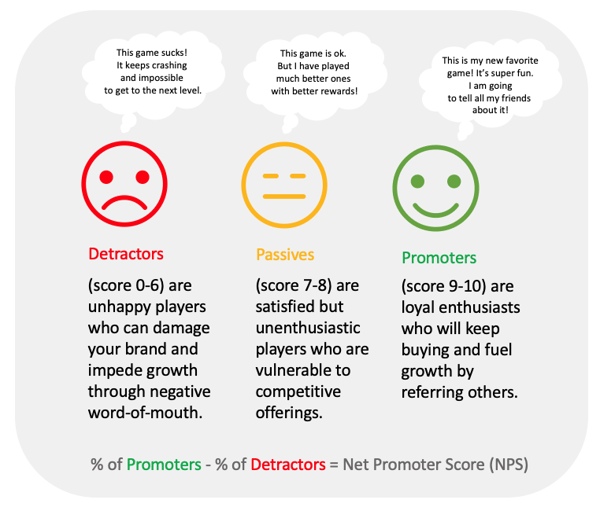
What Is A Good Net Promoter Score?
Now you’ve got your score. Great. But how do you know if your NPS indicates your game is ‘all that’ or if you got some work to do? Glad you asked.
Let’s say your scores come in as follows (N=20): 10, 10, 10, 9, 9, 9, 8, 8, 8, 7, 6, 6, 5, 4, 4, 3, 3, 2, 1, 1
- 6 out of 20 are promoters = 30%
- 10 out of 20 are detractors = 60%
Net Promoter Score = % Promoters – % Detractors
30% - 60% = -30
NPS scoring works like this:
- The highest score you can get is +100. EG, if everyone gives you a score of 10, that means 100% of your players are promoters.
- The lowest score you can get is -100. EG, if everyone gives you a score of 0, that means 100% of your players are detractors.
- Any score above zero is good.
- Any score above +50 is excellent.
- Any score above +70 is world-class.
- Of course, anything sub-zero means you have some work to do.
Benefits of NPS
The Net Promoter Score is considered the gold standard customer experience metric. But while used by millions of businesses to measure and track how they’re perceived by their customers, the NPS is much more than segmenting between poor and positive feedback.
Here are 7 benefits to Net Promoter Score you should know about:
- It measures the likelihood of new and repeat business
- It provides customer sentiment about your business as a whole
- It’s relevant to all aspects of your business
- It gives direction for change and improvement (with follow up questions)
- It’s simple, easy to understand, and easier to implement
- It’s a great way to track overall business trends
- It’s easy to benchmark against competitors
Transactional vs Relational NPS
Transactional NPS surveys are sent out after your customer interacts with your company. For example, if they make a purchase, call support, or communicate via live chat. This type of NPS survey is designed to get feedback about a specific topic and understand customer satisfaction at a micro-level.
Relational NPS surveys are intended to be used on a regular basis, either annually, quarterly, or even monthly. With this type of NPS survey, you can start to identify trends in player sentiment towards your game and company as a whole over time. TapResearch’s longitudinal view makes benchmarking easy and helps you quickly see trends - identifying company success or potential challenges.
How To Use Your Mobile Game to Improve Your NPS
This is where the rubber meets the road. Whether you’re talking about transactional or relational NPS, both have one thing in common - customer engagement. Or more directly, how your players perceive your engagement with them. Therefore, one of the easiest, more powerful ways to effectively improve your NPS is by soliciting feedback from your players. And maybe even implementing some of their feedback. Something you likely want to do already anyway.
The benefits of proactive player engagement can be immeasurable!
Using TapResearch’s own surveying tool, Player Insights, we surveyed 2000 mobile game players (U.S Census balanced) and, among the many insights it revealed, players overwhelmingly had positive sentiment towards the game publisher if they used their feedback in the games (see below):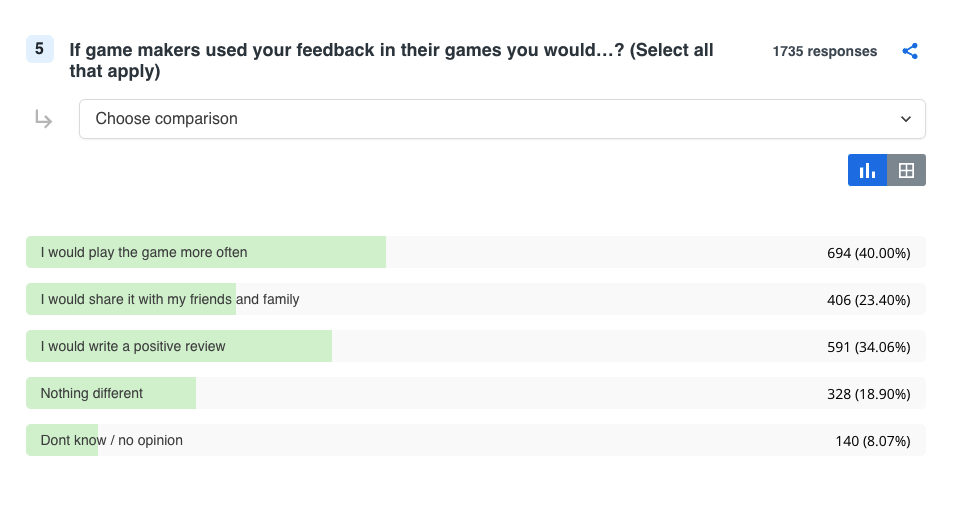
As you can see from the results, the top 3 answers would all have a direct, positive impact on your game and would also likely lead to a very favorable NPS. But the problem is traditional methods of engaging players have a fatal flaw - it’s AFTER the fact
For years, player feedback has been solicited in social channels or via an in-game survey that takes the player out of the game experience - clearly not a great player experience. This traditional way of gathering feedback from players is passive, slow, and off-putting to players, which often translates into poor and low response rates. That’s why proactively engaging your players about something they care about, the game, and rewarding them with game currency to answer a few simple questions about your game, while they’re IN the game, is the key to reducing churn, improving player retention, and increasing player LTV.
You are happy to get the player insights in real-time and they are happy to get rewarded with the game currency they can use in the game, and they get to continue playing. When your players are happy, that shows up in your NPS. Do you know where else it shows up? In-app stores as positive reviews, which translates into increased player acquisition and increased daily active users. It’s these reasons you should care about your NPS!
Using Rewarded In-Game Surveys To Boost Your NPS
Proactively engaging your players in-game is easier than you think. And with TapResearch surveys, you can offer rewards for answering a few quick questions.
We’ve included some example questions below to help get you thinking about all the potential questions you could ask your player audience:
- Why did you download <your game>?
- What kind of rewards do you prefer?
- What kind of boosters do you like?
- Did you find this level too hard?
- Is this game too complex or too easy?
- What did you think of our recent update?
- When would you prefer to take a survey in the game?
- Do you prefer smaller surveys with smaller rewards or longer surveys with bigger rewards?
- The list goes on and on.
There are so many opportunities to engage your players in a positive way to make them feel a part of your community and to feel like they have a direct connection to your game. It’s a win-win for you and your players. They get rewarded for answering your questions. You get rewarded with lower churn, increased retention, high DAU, better LTV, and positive sentiment that translates into word-of-mouth marketing and positive review. It’s a no-brainer.
The Net Promoter Score Survey Question
Here is what that all-important NPS survey question looks like: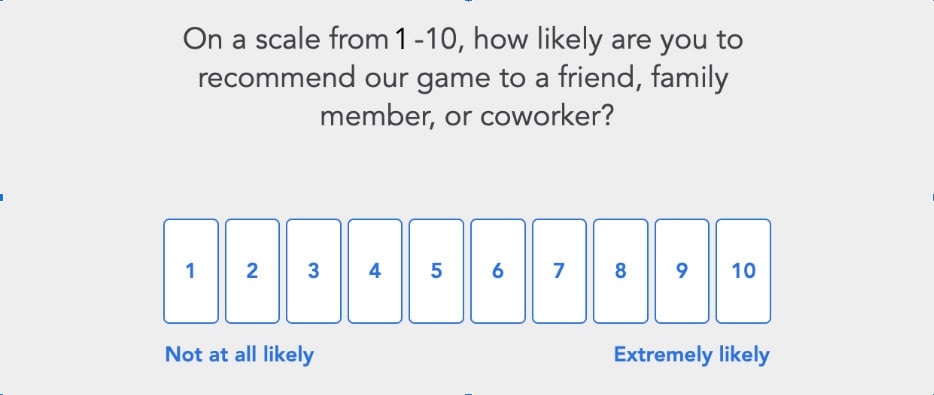
The Net Promoter Score Follow Up Survey Question
Following up your NPS survey question by asking your players why they gave you the score they did will go a long way towards understanding what your players love about your game, what they dislike, and what makes them go ‘meh’. In turn, this gives you the player insight you need to improve, fix, update, and optimize your game.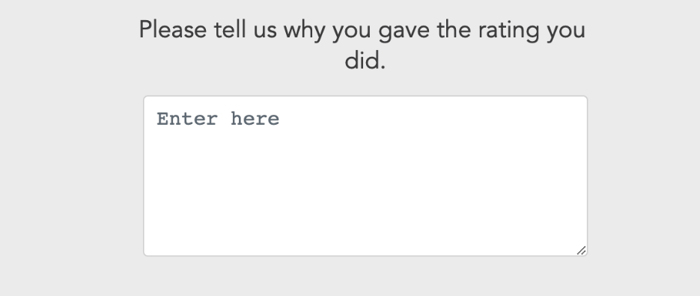
As you can see, NPS goes hand-in-hand with reducing churn, increasing retention, and boosting DAU and LTV. You can significantly improve your Net Promoter Score, along with other critical customer experience metrics like your Customer Satisfaction (CSAT) score and Customer Effort Score (CES), by simply doing what you want to be doing anyway - engaging your players. And using rewarded surveys makes it easier than ever.
Ready to learn more about TapResearch and how Rewarded Surveys can generate new revenue and growth for your game? Contact us here to learn more.